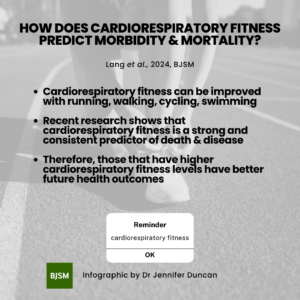Key words: Cardiorespiratory fitness, health outcomes, adult, clinical
In this blog we summarise a recent large meta analysis, published in BJSM that reviewed the evidence linking cardiorespiratory fitness to future health outcomes (1).
What is cardiorespiratory fitness?
Cardiorespiratory fitness, often referred to as aerobic fitness or endurance, reflects the ability of the heart, lungs, and blood vessels to deliver oxygen to support sustained physical activity. Engaging in regular physical activity such as walking, running, swimming, or cycling can help maintain or improve cardiorespiratory fitness. The amount of physical activity needed to improve cardiorespiratory fitness depends on many individual factors such as genetics, age, sex, overall health, and lifestyle factors. Ultimately, the key to improving health through physical activity lies in discovering activities that bring joy and fulfillment!
Why is this study important?
Our research team committed significant effort to study physical fitness across all people of all ages. We compared present day fitness levels to historic fitness levels (2), fitness between countries (3), as well as established norms for fitness tests (4, 5). We identified that some measures of physical fitness, particularly cardiorespiratory fitness, are strongly linked to health. However, despite strong evidence, these measures are not often used in public health and clinical settings. This study emphasises the public health and clinical importance of cardiorespiratory fitness, thereby informing future decision-making processes.
How did we go about this study?
We conducted an overview of systematic reviews that included a meta-analysis to gain an overall understanding of the available evidence. This method has several benefits. Firstly, as the name suggests, it’s a systematic approach to synthesize all relevant evidence from existing systematic reviews. Secondly, it helps identify major research gaps and areas that would benefit from a new systematic review. Thirdly, it allows the certainty of the evidence to be independently assessed, identifying areas that require better evidence. Lastly, it is a valuable tool for policymakers, clinicians, and guideline developers by providing a comprehensive picture of the current evidence landscape.
Our study took nearly 2 years to complete and involved screening 1000s of papers. This study was a large international effort by researchers from Canada, Spain, Australia, and the USA.
What did the study find?
Our study synthesized data from 26 systematic reviews, representing over 20.9 million observations from 199 unique cohort studies. The findings clearly support adult cardiorespiratory fitness as a strong and consistent predictor of death and disease.
For the general population, we identified reviews linking cardiorespiratory fitness to various outcomes, including to all-cause mortality, cardiovascular disease mortality, sudden cardiac death, as well as cancer mortality. For newly diagnosed chronic diseases, higher cardiorespiratory fitness was linked with lower risk of high blood pressure, heart failure, stroke, atrial fibrillation, dementia, chronic kidney disease, depression, and type 2 diabetes.
We also found improved survival rates associated with higher levels of cardiorespiratory fitness for patients living with chronic kidney disease, heart failure, peripheral artery disease, cardiovascular disease, interstitial lung disease, cancer, pulmonary hypertension, amyloid cardiomyopathy, and coronary artery disease.
What are the key take-home points?
Our findings consistently showed significantly greater protection for individuals with higher cardiorespiratory fitness levels, regardless of the outcome or population. The overwhelming evidence highlights cardiorespiratory fitness as a powerful marker of future health outcomes.

References:
- Lang JJ, Prince SA, Merucci K, et al Cardiorespiratory fitness is a strong and consistent predictor of morbidity and mortality among adults: an overview of meta-analyses representing over 20.9 million observations from 199 unique cohort studies British Journal of Sports Medicine 2024;58:556-566.
- Tomkinson GR, Lang JJ, Tremblay MS. Temporal trends in the cardiorespiratory fitness of children and adolescents representing 19 high-income and upper middle-income countries between 1981 and 2014. British journal of sports medicine. 2019 Apr 1;53(8):478-86.
- Lang JJ, Tremblay MS, Léger L, Olds T, Tomkinson GR. International variability in 20 m shuttle run performance in children and youth: who are the fittest from a 50-country comparison? A systematic literature review with pooling of aggregate results. British Journal of Sports Medicine. 2018 Feb 1;52(4):276-.
- Tomkinson GR, Lang JJ, Tremblay MS, Dale M, LeBlanc AG, Belanger K, Ortega FB, Léger L. International normative 20 m shuttle run values from 1 142 026 children and youth representing 50 countries. British journal of sports Medicine. 2017 Nov 1;51(21):1545-54.
- Mayhew AJ, So HY, Ma J, Beauchamp MK, Griffith LE, Kuspinar A, Lang JJ, Raina P. Normative values for grip strength, gait speed, timed up and go, single leg balance, and chair rise derived from the Canadian longitudinal study on ageing. Age and Ageing. 2023 Apr 1;52(4):afad054.
Authors: Drs. Justin J. Lang (1,2) & Grant R Tomkinson (2)
(1). Centre for Surveillance and Applied Research, Public Health Agency of Canada, Ottawa, Ontario, Canada
(2). Alliance for Research in Exercise, Nutrition and Activity (ARENA), Allied Health and Human Performance, University of South Australia, Adelaide, South Australia, Australia